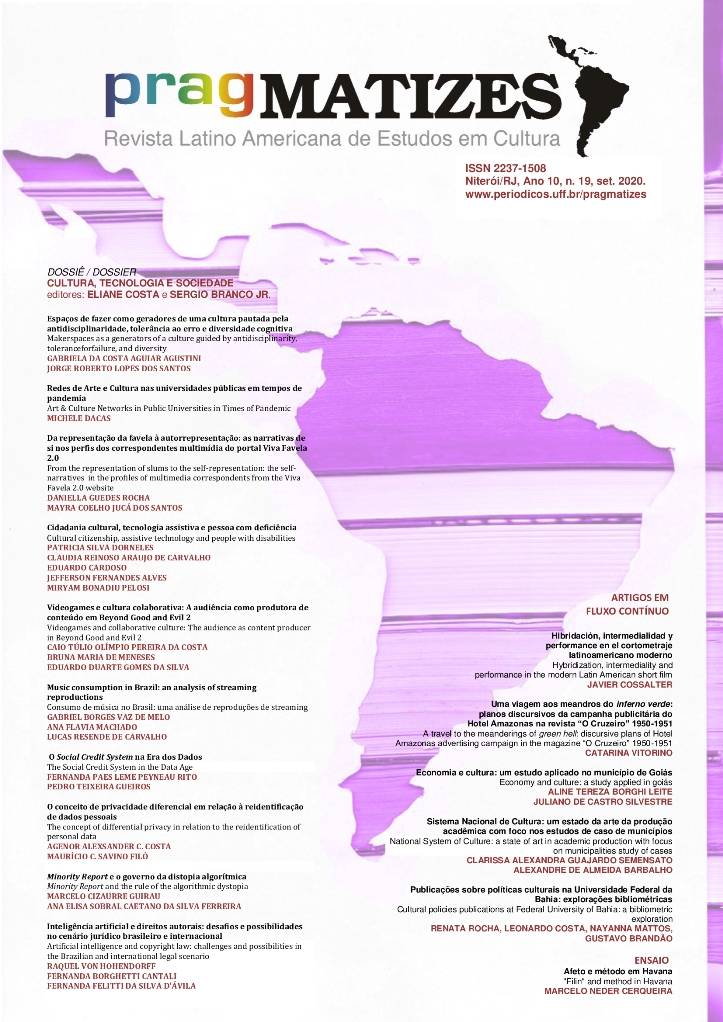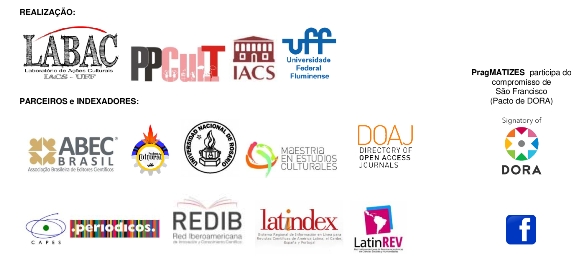Music consumption in Brazil: an analysis of streaming reproductions
DOI:
https://doi.org/10.22409/pragmatizes.v10i19.40565Palavras-chave:
consumption, music, genre, streamingResumo
Music is one of the cultural segments that most adapts and innovates, as observed in the recent rise of streaming services. The consumption of digital music has altered the dynamics of the market and the way people enjoy it. The aim of this article is to show trends and tastes of Brazilian individuals, taking into account musical genres. For this purpose, it uses data of playlists collected from the Spotify streaming platform through its API. The results show that genres such as sertanejo universitário and international pop have great national reach. However, other national genres and artists with less popularity have a relevant and distinct demand in some Brazilian cities. Our analysis indicates both the maintenance of the traditional consumption as the rise of the mass-replacement model. Therefore, a regionalization of the musical taste in Brazil is evidenced,which suggests a potential of musical niches in the context of the streaming market.
Downloads
Referências
AGUIAR, L.; WALDFOGEL, J. Streaming Reaches Flood Stage: Does Spotify Stimulate or Depress Music Sales? NBER Working Paper, (w21653). Available at SSRN: https://ssrn.com/abstract=2679691. 2015.
AGUIAR, L.; WALDFOGEL, J. Even the losers get lucky sometimes: New products and the evolution of music quality since Napster. Information Economics and Policy, Elsevier, v. 34, p. 1–15, 2016.
ANDERSON, C. A Cauda Longa. Rio de Janeiro: Elsevier Brasil, 2006.
CAVES, R. E. Organization of arts and entertainment industries. Handbook of the Economics of Art and Culture, Elsevier, Amsterdã, v. 1, p. 533–566, 2006.
COULANGEON, P.; LEMEL, Y. Is “distinction” really outdated? Questioning the meaning of the omnivorization of musical taste in contemporary France. Poetics, Elsevier, v. 35, n. 2, p. 93–111, 2007.
CVETKOVSKI, T. The Political Economy of the Music Industry: Its Rise and Stall. In: Australasian Political Studies Association Conference. Adelaide: University of Adelaide, 2004.
FELLOWS, I. wordcloud: Word Clouds. R package version 2.5. 2014.
LEYSHON, A. Reformatted: Code, Networks, and the Transformation of the Music Industry. Oxford: Oxford University Press, 2014.
LIEBOWITZ, S. J. Will MP3 Downloads Annihilate the Record Industry? The Evidence so Far. In: LIBECAP, G. (Ed.). Intellectual Property and Entrepreneurship. Emerald Group Publishing Limited, 2004. p. 229–260.
LIEBOWITZ, S. J. How much of the decline in sound recording sales is due to file-sharing? Journal of Cultural Economics, Springer, v. 40, n. 1, p. 13–28, 2014.
MCDONALD, G. Every Place at Once. 2013. http://everynoise.com/everyplace.cgi. Accessed 28 August 2018.
OBERHOLZER-GEE, F.; STRUMPF, K. The effect of file sharing on record sales: An empirical analysis. Journal of Political Economy, The University of Chicago Press, v. 115, n. 1, p. 1–42, 2007.
PARK, J.; CELMA, O.; KOPPENBERGER, M., CANO, P., BULDÚ, J. M. The social network of contemporary popular musicians. International Journal of Bifurcation and Chaos, World Scientific, v. 17, n. 07, p. 2281–2288, 2007.
PAULAFREITAS, A. Música de rua de Salvador: preparando a cena para a axé music. In: CULT. I ENECULT – Encontro de Estudos Multidisciplinares em Cultura. Salvador, 2004.
PELTIER, S.; BENHAMOU, F.; TOURÉ, M. Does the long tail really favor small publishers? Journal of Cultural Economics, Springer, p. 1–20, 2015.
PETERSON, R. A. Understanding audience segmentation: From elite and mass to omnivore and univore. Poetics, Elsevier, v. 21, n. 4, p. 243–258, 1992.
POTTS, J. New technologies and cultural consumption. In: GINSBURGH, V. A.; THROSBY, D. (Ed.). Handbook of the Economics of Art and Culture. 2. ed. Amsterdam: Elsevier, 2014. p. 215–231.
PREY, R. Now Playing. You: Big Data and the Production of Music Streaming Space. Doctoral dissertation. Communication, Art & Technology: School of Communication. Simon Fraser University, 2015.
PRÓ-MÚSICA BRASIL, P. F. A. Mercado Fonográfico Mundial e Brasileiro em 2016: Relatório Anual Eletrônico Pró-Música Brasil. 2017. https://pro-musicabr.org.br/home/numeros-do-mercado/. Accessed 17 September 2018.
QGIS Development Team. QGIS Geographic Information System. Open Source Geospatial Foundation, 2009.
R Core Team. R: A Language and Environment for Statistical Computing. R
Foundation for Statistical Computing, Vienna, Austria, 2018.
RICHARDSON, L. Beautiful Soup Documentation, 2017. https://buildmedia.readthedocs.org/media/pdf/beautiful-soup-4/latest/beautiful-soup-4.pdf. Release 4.4.0. Accessed 28 November 2018.
SPOTIFY. Spotify Web API, 2014. b API. https://developer.spotify.com/web-api/. Accessed 28 August 2018.
SPOTIFY. Spotify Charts, 2016. https://spotifycharts.com/regional. Accessed 28 August 2018.
THROSBY, D. The Music Industry in the New Millennium: Global and local perspectives. Global Alliance for Cultural Diversity, UNESCO Division of Arts and Cultural Enterprise, 2002.
WICKHAM, H. ggplot2: Elegant Graphics for Data Analysis. Springer-Verlag New York, 2016.
AUTHOR, 2017.
Downloads
Publicado
Edição
Seção
Licença
Autores que publicam nesta revista concordam com os seguintes termos:- Autores mantém os direitos autorais e concedem à revista o direito de propriedade, com o trabalho simultaneamente licenciado sob a Licença Creative Commons Attribution que permite o compartilhamento do trabalho com reconhecimento da autoria e publicação inicial nesta revista.
- A revista se reserva o direito de efetuar, nos originais, alterações de ordem normativa, ortográfica e gramatical.
- As provas finais não serão submetidas aos autores.
- As opiniçoes emitidas pelos autores são de sua exclusiva responsabilidade.



